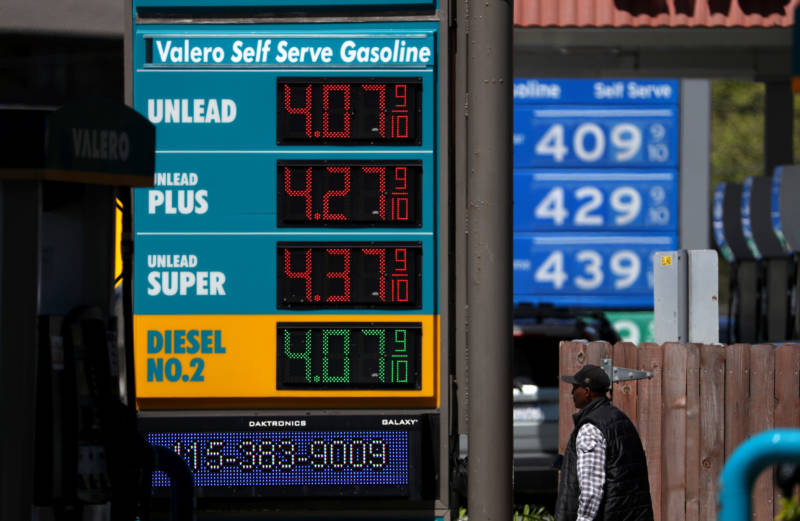On the environmental side, we fork out extra because of the state’s cap-and-trade program — which requires several industries, including fuel wholesalers, to cut down on carbon emissions — as well as California’s low carbon fuel standard. This regulation directly targets fuel producers and requires them to limit the creation of greenhouse gases in the production, transportation and use of fuel in the state.
The actual amounts of these extra environmental costs fluctuate on a regular basis, but right now cap-and-trade costs us an additional 14 cents per gallon and the low carbon fuel standard adds another 13 cents, according to Severin Borenstein, the faculty director of UC Berkeley’s Energy Institute, who has studied gas prices for years.
And then there’s the extra cost of refining California’s gasoline. We pay an extra 5 to 10 cents per gallon because the California Air Resources Board requires that the gas we put into our cars be made from a formula producing less air pollution.
Borenstein is quick to point out that these extra costs have real benefits when it comes to combating climate change and air pollution.
“Studies have shown that California has been able to much more effectively clean up our air quality,” Borenstein said. “If you’re in the middle of Los Angeles and you look toward the mountains, you now see the mountains, which wasn’t the case 30 years ago.”
But adding up the environmental costs and the gas taxes doesn’t get you anywhere near the current difference between what Californians pay at the pump versus the rest of the country. So what about the rest?
What We Don’t Know: ‘Mystery Gas Surcharge’
“Prior to 2015, the (gas price) differential between California and the rest of the country was pretty much completely explained by our higher taxes and environmental fees and the cost of making our cleaner gasoline,” Borenstein said.
But starting in 2015, a new price gap of 20 to 30 cents opened up, one that neither Borenstein — nor anyone else — can find the cause of.
It started on Feb. 18, 2015, after an explosion at an Exxon refinery in Torrance, just outside Los Angeles. The refinery was shut down for more than a year, and gas prices in the state shot up, as they usually do when a refinery goes offline unexpectedly.
These unplanned outages are an even bigger issue in California because the state is what’s known as a “petroleum island.” We don’t have pipelines connecting refineries in Los Angeles to those in the Bay Area or to the rest of the country. Plus, not many refineries make the special better-for-the-environment gasoline that the state requires.
So if there’s a production gap, there are only a few places gas stations can turn to, and that gas has to come in by ship, which costs more and can take weeks to arrive.
According to Borenstein, it usually takes a month or two for gas prices to come back down after that kind of spike. But after the 2015 explosion, “that just didn’t happen, and ever since then we’ve seen this additional differential.”
This additional differential is what Borenstein calls the “mystery gasoline surcharge.” He says right now it’s costing Californians about $20 million per day in higher fuel costs — and $20 billion and counting since 2015.
“We don’t know if it’s because (gasoline suppliers) are gouging, or because there is some additional cost that hasn’t been accounted for and that cropped up in 2015,” Borenstein said.
One thing we do know is that many Californians get their gas from big-name brands, including Chevron, Shell, Exxon, Mobil and 76, which charge 11 to 16 cents more per gallon than ARCO, unbranded gas stations and grocery stores like Costco and Safeway that also sell gas, according to the California Energy Commission.
According to a preliminary report from the commission last month, “While this practice is not necessarily illegal, it may be an effort of a segment of the market to artificially inflate prices to the detriment of California consumers and could account for at least part of the price differential.”
Is There Anything We Can Do?
In January, 19 state legislators asked Attorney General Xavier Becerra to look into the mystery gasoline surcharge, and in April, Gov. Gavin Newsom asked the California Energy Commission to look into the state’s high gas prices. The commission quickly produced the report quoted above and asked for more time to do a deeper investigation.
“I am hopeful that between the attorney general’s office and the California Energy Commission, they will be able to get to the bottom of what’s going on and bring our gas prices down a bit,” Borenstein said.
Until then, there are a few things Borenstein said consumers can do to try to save themselves a little pain at the pump.
He recommended buying gas from off-brand retailers, planning ahead so you don’t end up having to fuel up in an especially expensive place like downtown San Francisco, and getting a more fuel-efficient car.

